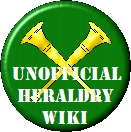Rule of Tincture
WARNING: Do not cite this page as a reference. This page is on this wiki to make the content "searchable" and easier to find. If you find the information you seek here, go to the original sources as linked below to verify the information and use them for your documentation.
Rule of Tincture.[edit | edit source]
from http://heraldry.sca.org/laurel/lessons/lesson01.html
Simply, the Rule of Tincture says that "good Contrast" must exist between the field and the charges upon it, or between a charge and the charges on it.
Good contrast exists between:
- A metal and a color
- An element equally divided of a color and a metal and any other element, provided identifiability is maintained
- A color and a charge blazoned proper that is predominantly light
- A metal and a charge blazoned proper that is predominantly dark
Some Definitions...
- Metals are argent and Or .


- Colors are azure, gules, purpure, sable/, and vert .




 ]]
]] - Ermine and erminois (gold with black spots) are counted as metals.


- Counter ermine and pean are counted as colors (black with silver/gold spots respectively).


- Vair and its variants are equally divided of a color and a metal.


- "Neutral" means "equally divided of a color and a metal".
So much for definitions...
[Now consider] the standard field divisions and the ordinary that corresponds to that line division Lesson 01 - Divisions and Ordinaries. How do you apply the rule of tincture to determine what tincture combinations are legal? In a divided field, neither portion lies over the other; they are next to each other. For this reason, it is not necessary for there to be good contrast between the parts of a divided field, so long as the field is divided into two parts, quarterly, or per saltire. A field divided into three parts (Per pall and Per pall inverted) must have good contrast between two of the parts. Any other field division must have good contrast between the parts.
Now for some examples:
- Per chevron gules and sable... is OK. Gules, a chevron sable... is not. The black chevron does not stand out against the red field.
- Per bend argent and purpure... is OK. Argent, a bend purpure... is also OK.
- Per pall sable, purpure, and gules... is not OK. Per pall sable, purpure, and Or... is OK.
- Quarterly argent and Or... is OK. Argent, a cross Or... is not. The gold cross is difficult to see against the white field.
- Per fess ermine and erminois... is OK. Ermine, a fess erminois... is not; the predominantly gold fess does not show up against the predominantly white field.
- Per fess vert and argent, a fess Or... is OK. The field is neutral, and the fess is neither of the tinctures of the field.
- Per bend gules and Or, a bend Or... is not OK. The portion of the bend on the Or field is invisible.
- On the field "Per chevron inverted purpure and Or..." you can place any tincture except Or and purpure (remember that erminois is functionally Or for contrast purposes, also).
Exceptions:[edit | edit source]
See also Individually Attested Pattern, Argent and Or, Azure and Gules, Azure and Purpure, Azure and Sable, Azure and Vert, Gules and Purpure, Gules and Sable, Gules and Vert, Purpure and Sable, Purpure and Vert, Sable and Vert
Regional Exceptions to the Rule of Tincture, Vol. 01 - https://www.facebook.com/notes/sca-heraldry-chat/regional-exceptions-to-the-rule-of-tincture-vol-01/10150677670804203
Regional Exceptions to the Rule of Tincture, Vol. 02 - https://www.facebook.com/notes/sca-unofficial-heraldic-consultation/regional-exceptions-to-the-rule-of-tincture-vol-02/10150837743659203/
WARNING: Do not cite this page as a reference. This page is on this wiki only to make the content "searchable" and easier to find. If you find the information you seek here, go to the original sources (generally linked) to verify the information and use them for your documentation.
